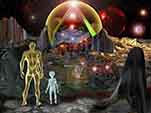https://eraoflight.com/2018/01/30/for-the-first-time-in-152-years-a-supermoon-blue-moon-and-total-lunar-eclipse-will-coincide/
On Jan. 31, it doesn’t matter what you’re doing—you owe it to yourself to gaze at the darkened sky.
In the early morning hours of the Western Hemisphere and the evening in the Eastern, you will be treated to both a visible supermoon—what we call a full moon at its closest orbital point to Earth—and a total lunar eclipse. The celestial coincidence hasn’t happened in more than 150 years. That means there were people who lived and died on this Earth without ever having had a chance to see this phenomenon, which won’t reappear again for another decade.
This supermoon also happens to be the final one in a supermoon trilogy—the first two of which appeared on Dec. 3 and Jan. 1. As the second full moon of the month, it earns the title of a blue moon as well.
And get ready for the blood moon
The moon on the night of Jan. 31 is, by a combination of low probabilities, exceedingly rare.
Visible supermoons appear 14% bigger and 30% brighter than full moons that occur at the farthest point in the moon’s orbit. During the eclipse, with totality visible from eastern Asia across the Pacific to western North America, the moon will slowly lose its brightness and take on a reddish hue because of the way the atmosphere bends the light, says NASA.
As a result, totally eclipsed moons are sometimes also called “blood moons.”
From supermoon to blood moon.
From supermoon to blood moon. (Ruaraidh Gillies/Wikimedia Commons)
When can I see the supermoon and total lunar eclipse?
The best time to enjoy a supermoon is right after moonrise and before sunrise, when the moon is sitting on the horizon. It will appear its biggest and brightest because of a “moon illusion” effect that’s created when you are able to compare the lunar body to other objects for scale, like buildings and foliage. Check your local moonrise time here.
For the real highlight of the show, the lunar eclipse will begin at 6:48am ET (11:48am UTC) and reach its maximum at 8:30am ET (1:30pm UTC). Viewers from eastern Asia, the Pacific, and western North America will get the best view, but viewers in eastern North America and Europe will also catch a partial eclipse. Here’s an interactive map of where you will be able to see the eclipse.
Can I see the supermoon and lunar eclipse without going outside?
If it’s too cloudy, or too cold, or you aren’t in the path of totality, there are options to view the celestial event online. The Virtual Telescope project provides a livestream of the supermoon’s eclipse over Rome’s skyline, beginning at 6:30am ET (11:30am UTC).
What’s the best way to photograph the lunar eclipse?
To take a picture of the supermoon or the lunar eclipse with a smartphone, tap on the moon on the screen and hold your finger in place to lock the camera’s focus. Then adjust the exposure slider that appears next to your finger to get the right balance of light for your shot.
If you’re using a DSLR, NASA’s senior photographer Bill Ingalls recommends that you use the daylight white balance to adjust for the sunlight being reflected off the moon. He says that it’s important to keep in mind that the moon is a moving object: “It’s a balancing act between trying to get the right exposure and realizing that the shutter speed typically needs to be a lot faster.”
To get an original shot, Ingalls suggests taking a picture that puts the moon in context of a local landmark, something that gives your photo a sense of place. “Don’t make the mistake of photographing the moon by itself with no reference to anything,” say Ingalls. “Everyone will get that shot.”
supermoon2
(Bill Ingalls/NASA)
Do I need special glasses to watch the supermoon and lunar eclipse?
Unlike the solar eclipse, the supermoon and the lunar eclipse are safe to view with the naked eye. There’s nothing to worry about if you find yourself enthralled and staring up into the sky for a very long time. Except maybe your neck.






































